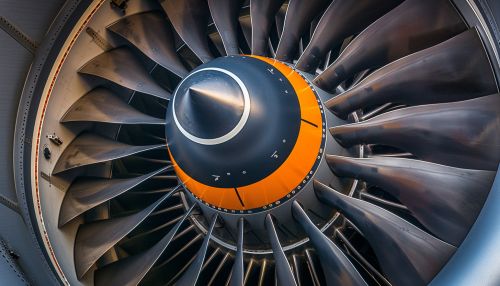Propulsion: Difference between revisions
No edit summary |
No edit summary |
||
| Line 46: | Line 46: | ||
[[Category:Transportation]] | [[Category:Transportation]] | ||
[[Image:Detail-77735.jpg|thumb|center|A close-up view of a jet engine, showing the intricate details of the turbine blades and combustion chamber.]] | [[Image:Detail-77735.jpg|thumb|center|A close-up view of a jet engine, showing the intricate details of the turbine blades and combustion chamber.|class=only_on_mobile]] | ||
[[Image:Detail-77736.jpg|thumb|center|A close-up view of a jet engine, showing the intricate details of the turbine blades and combustion chamber.|class=only_on_desktop]] | |||
Latest revision as of 12:03, 7 May 2024
Introduction
Propulsion is the action or process of pushing or pulling to drive an object forward. The term is derived from two Latin words: "pro", meaning before or forward; and "pellere", meaning to drive. A propulsion system consists of a source of mechanical power, and a propulsor (means of converting this power into propulsive force). A technological system uses an engine or motor as the power source, and wheels and axles, propellers, or a propulsive nozzle to generate the force. Components such as clutches or gearboxes may be needed to connect the motor to axles, wheels, propellers, or nozzles. Combustion engines are often used but electric motors are becoming increasingly common. Various types of propulsion systems are found in applications such as automobiles, aircraft, watercraft, robots, and even spacecraft.
Types of Propulsion Systems
There are various types of propulsion systems, each with its own unique characteristics and uses. The most common types include chemical propulsion, electric propulsion, and nuclear propulsion.
Chemical Propulsion
Chemical propulsion involves the use of chemical reactions to create a high-pressure gas that can be directed through a nozzle, creating thrust. This is the principle behind both rocket engines and jet engines, although the specifics of the chemical reactions and the ways the high-pressure gas is used differ between these two types of engines.
Electric Propulsion
Electric propulsion systems use electrical energy to accelerate propellant or create thrust. This can be done through a variety of methods, including electrothermal, electrostatic, and electromagnetic. Electric propulsion systems are commonly used in spacecraft due to their high efficiency and low propellant mass requirements.
Nuclear Propulsion
Nuclear propulsion involves using a nuclear reaction to generate heat, which is then used to create a high-pressure gas for thrust. This type of propulsion system is primarily used in submarines and spacecraft.
Principles of Propulsion
The basic principle of propulsion is Newton's third law of motion, which states that for every action, there is an equal and opposite reaction. In terms of propulsion, this means that if a system expels mass in one direction, it will experience a force in the opposite direction.
Thrust
Thrust is the force that moves an aircraft through the air. It is produced by the propulsion system of the aircraft. The amount of thrust generated depends on several factors, including the type of engine, the size of the engine, and the speed of the aircraft.
Propulsive Efficiency
Propulsive efficiency is a measure of how effectively a propulsion system converts energy into useful work. It is defined as the ratio of the useful power output to the total power input. The propulsive efficiency of a system can be improved by optimizing the design of the system and by operating the system at optimal conditions.
Applications of Propulsion Systems
Propulsion systems are used in a wide range of applications, from transportation to space exploration.
Transportation
In transportation, propulsion systems are used to move vehicles such as cars, trucks, trains, ships, and airplanes. The most common types of propulsion systems used in transportation are internal combustion engines and electric motors.
Space Exploration
In space exploration, propulsion systems are used to launch spacecraft into space, maneuver them in space, and bring them back to Earth. The most common types of propulsion systems used in space exploration are chemical rockets and electric propulsion systems.
Future of Propulsion
The future of propulsion technology is likely to be shaped by a number of factors, including advances in materials science, improvements in energy storage and generation technologies, and the need for more sustainable and efficient forms of transportation. Some areas of ongoing research and development include advanced electric propulsion systems, nuclear propulsion for deep space missions, and renewable biofuels for aviation.
See Also


